For about two dozen egg rolls, you'll need:
1 lb ground pork
1/2 to 1 lb shrimp, minced or ground in a food processor
1 package spring roll or rice paper wrappers
1 small section bean thread vermicelli. They're sold individually or in packages, but the packages will tie a small bundle together. You just need one.
1 cup dried mushrooms, soaked and sliced, or 1 cup Tree/Wood Ear Fungus/Mushroom, soaked
1 large onion, minced or grated
1 or 2 carrots, peeled and grated
1 egg, beaten
1 tsp salt, adjust to taste
1 tsp sugar, adjust to taste
1 tsp black pepper, adjust to taste
2 tsp Nuoc Mam (Vietnamese Fish Sauce), adjust to taste
Optional: Ground turkey or chicken may be substituted for the pork. Add shredded cabbage if you'd like more vegetables. Add minced crab to make it even more flavorful. Vegetarians may substitute the meats with fresh tofu, just make sure to drain the excess water.
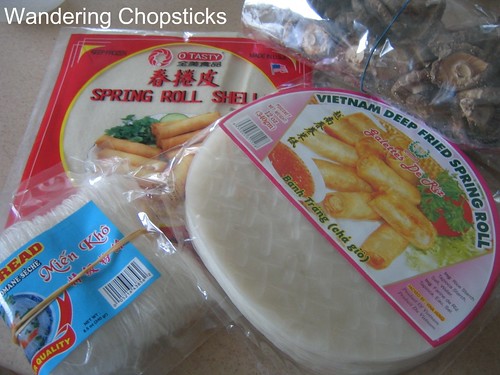
Dried mushrooms, tree ear fungus, and bean thread vermicelli need to be rehydrated. Soak in warm water for about 15 minutes. If you want to speed along the softening process, use boiling water. Squeeze vermicelli and mushrooms dry and allow to drain. Cut vermicelli into two-inch segments. I use a pair of scissors for ease. Cut off mushroom stems and slice thinly. Sometimes tree ear fungus is sold pre-sliced, if not, then slice into strips.
Mix everything thoroughly. To check for taste, I usually take a tiny lump of the meat and pop it into the microwave for 30 seconds or so. It's easier to adjust seasonings if necessary this way. Just remember to factor in that the fish sauce will make the mixture saltier as it gets absorbed and cooked.
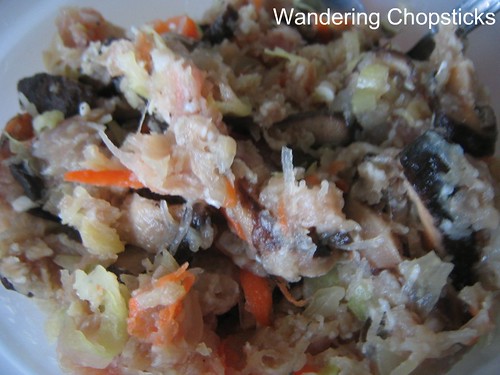
You should only wrap enough egg rolls for however many you plan to eat right then. They don't keep so well. Store the filling in the fridge if you plan to make more egg rolls over the next few days. Otherwise, you can also freeze the leftover filling for use the next time you have a craving.
Now, in rolling an egg roll, don't be greedy. You're not making a burrito here. A tablespoon, or slightly more, is more than enough filling. Spread it out on top of the wrapper.
If you're making them as appetizers for a party and want them smaller, simply cut the wrappers in half. It's easier to do this when they're still stuck together, and then separate them after they've been cut.
If using rice paper wrappers, just wet the rice paper in a bowl of water or under running water. Allow a few seconds for it to get pliable and then put in the filling. Do only one or two at a time, if you try to moisten them all at once, they'll get mushy by the time you get to wrapping them.
Chinese egg roll wrappers do not need to be soaked before wrapping.
Fold down the top and pinch in to make the filling tight with the wrapper.
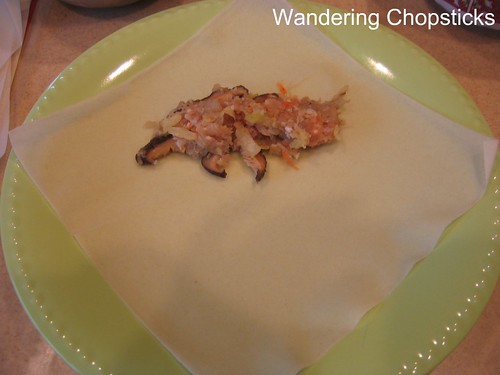
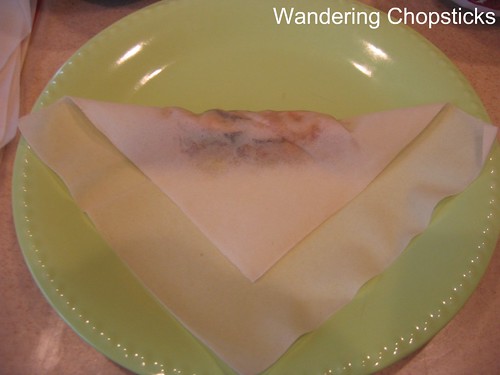
Fold in the two sides where it just touches the filling. Try to keep the sides straight so the egg roll will be even.
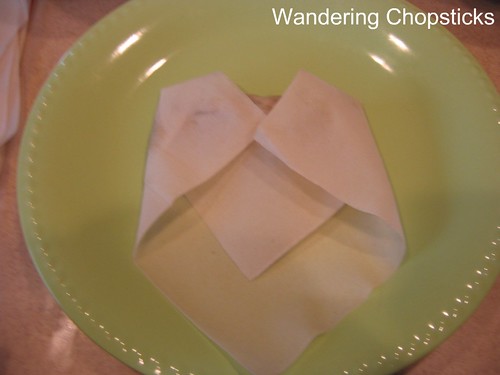
Keep pinching to hold the filling tightly inside the wrapper.

It's not just aesthetically pleasing to make a tight roll, it also keeps out excess oil when deep-frying. Moisten the tip to hold everything together. You could also use egg whites for this.
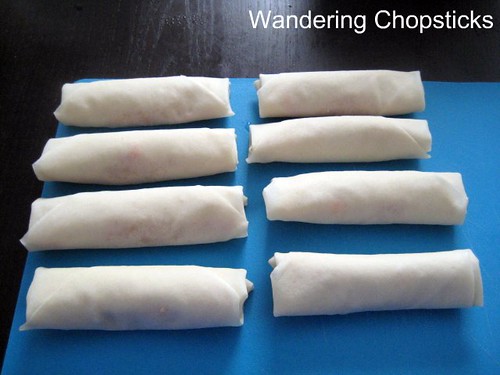
As an aside, my brother starts his rolling from the bottom and goes up. He insists that method is reflective of him being more giving. Read: my top rolling toward me approach must mean I take and take. Do you agree? Is your egg rolling method reflective of your personality?
Fill a wok or fry pan with several inches of oil, and an optional 2 teaspoons of white vinegar. You need enough oil that the egg rolls won't touch the pan so that it can cook evenly. The vinegar helps to make the egg rolls crispy. Do this first and then turn to medium heat or else the vinegar will make the oil splatter. As for oil, I recommend canola or safflower because they're tasteless and healthier than just vegetable or corn oil. Don't use olive oil because it has a different heating point and isn't as effective for deep frying. The lower temperature is needed to thoroughly cook the raw meat, and allow the wrappers to reach golden perfection. Turning the temperature too high will burn the wrapper, without cooking the meat. To test if the oil is hot enough for frying, flick some water into the pan. If it starts sizzling, the oil is ready for frying.
If you're using Vietnamese rice paper for your egg rolls. The wet and thicker wrapper takes longer to cook. Put the heat on medium-high so that the wrappers can puff up and become flaky, then they'll turn golden. By the time the wrappers are crispy golden, the filling should be cooked. If you're making both methods, cook the Chinese egg roll wrappers first and then turn the heat up to fry the Vietnamese rice paper-wrapped egg rolls. Otherwise, at a lower temperature, the Vietnamese rice paper won't puff up and will remain white long after the filling is cooked.
I had a question about smells. My mom used to have a portable burner and did all her frying and smelly cooking either outside or in the garage. I just crank up the vent and the air purifier on high and let it get to work. The air purifier usually gets rid of the smell by the end of the day.
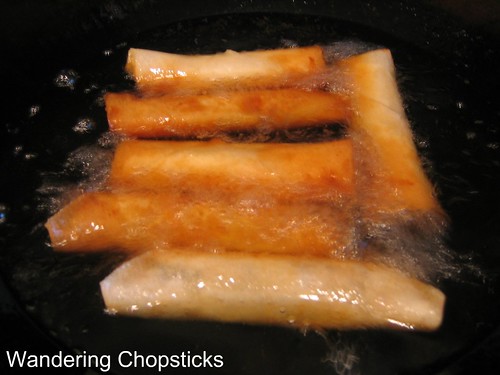
I learned this trick from a Jewish cookbook on how to keep Latkes (Jewish Potato Pancakes) crispy. Drain on brown paper bags, it'll absorb oil but won't make the egg rolls soggy like draining on paper towels will.
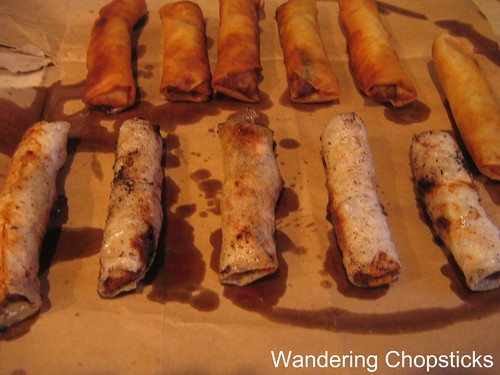
Allow to cool and serve with Nuoc Mam Cham (Vietnamese Fish Dipping Sauce) or just plain. Or wrap an egg roll inside a lettuce leaf and herbs and eat them southern Vietnamese-style.
The Vietnamese rice paper wrapper is the one in white. Rice paper wrappers usually end up slightly chewy in the center, light and flaky on the outside, but Chinese egg roll wrappers are a good reliable favorite.

Enjoy!
Read more: http://wanderingchopsticks.blogspot.com/2007/01/cha-gio-vietnamese-springegg-rolls.html#ixzz36oS7hpd0